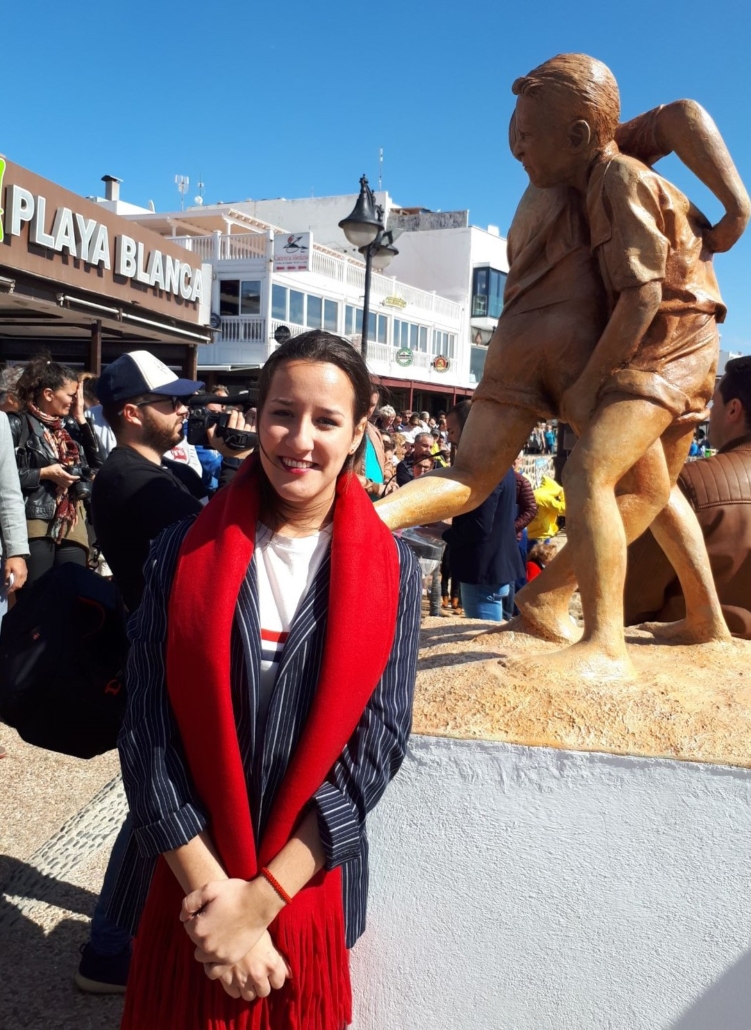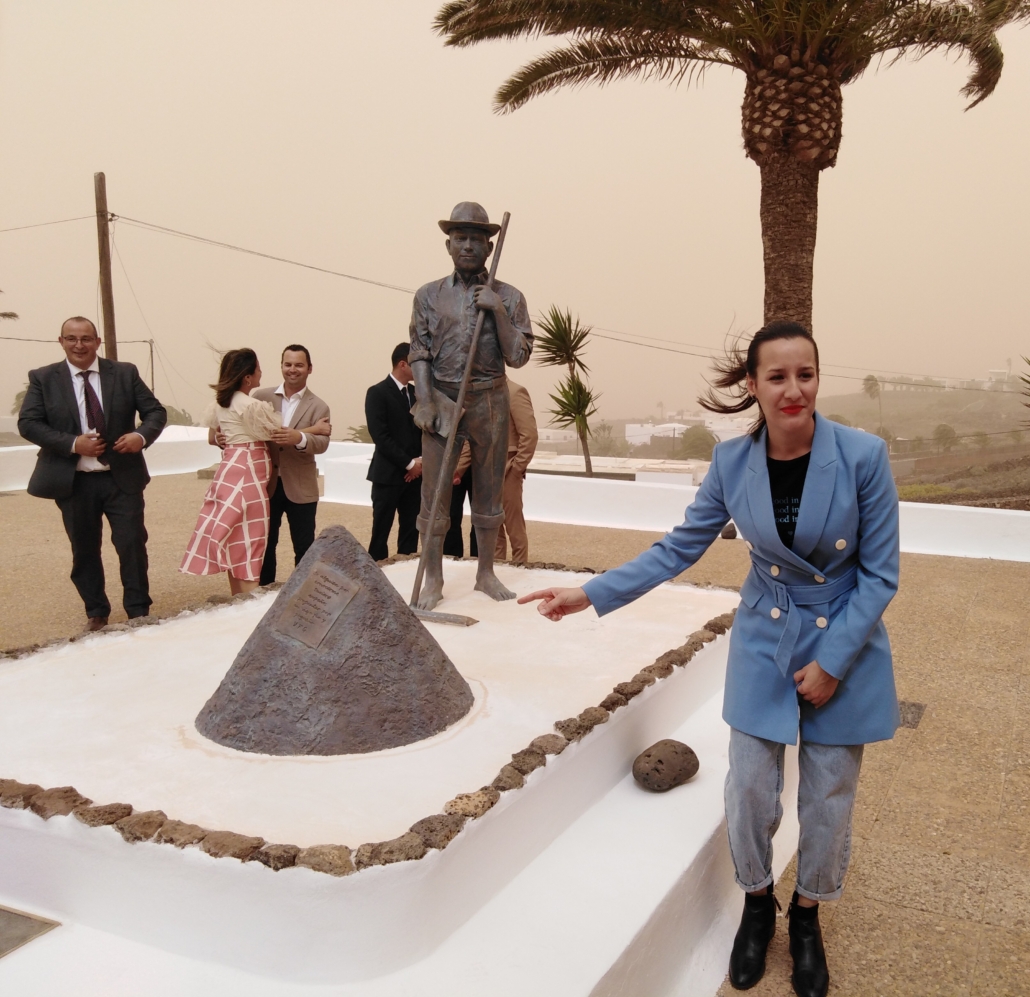CINTIA MACHIN, sculptor
CINTIA MACHIN, sculptor
commemorates and celebrates working women
by Norman Warwick
The sculptor Cintia Machin, a young Lanzarote woman, speaks, with great pride of her beginnings, as she recalls her childhood in the area of La Salina de Janubio, in Yaiza.
Sidetracks And Detours featured her work in article on 16th June 2021, that remains available in our easy to negotiate archives of more than 1,000 arts-related items, and of course we have closely followed her career since then.
She started in the art world from a very early age, copying great artists such as Velázquez, That realistic copying has been a great influence on her career and that it has helped her to perfect the style she possesses and that she defines as realistic. In her time in compulsory education, Cintia entered art competitions in which she obtained prizes for her works, motivating her to continue in following her art, so she decided to study Fine Arts at the Complutense University of Madrid.
The Canarian school of art has been of vital importance to study art in our islands, so Cintia names as a reference the late Lanzarote artist César Manrique.
Rigoberto Camacho is another of the outstanding artists for her, and she offered an impressive appreciation of his work, saying it had given her the opportunity to learn from him in his workshop, with an artist working in the same genre, had added value in her training, sharing both the same style.
The president of the Cabildo (government) of Lanzarote, Oswaldo Betancort, recently inaugurated a sculpture made in honour of the women who worked hard in the island’s canning industry in the nineteen sixties and seventies. Lancelot Digital reported that the figure pays tribute to the strength and resilience of those women who joined the world of work around extractive fishing and its industrial transformation in a time of great economic explosion
The unveiling of the sculpture (see our cover photograph), designed by the Lanzarote artist Cintia Machín, (an artist about whom you can find out more from the easy to negotiate archives of over 1,000 articles in my own daily not-for-profit blog at Sidetracks And Detours), took place as part of the commemoration of the International Day of Rural Women, which is celebrated every October 15. In addition to the sculptor and women who worked from a very young age in the factories of Arrecife, the unveiling was attended by the vice president of the Cabildo, Jacobo Medina; the Minister of Equality, Marci Acuña, and the Mayor of Arrecife, Yonathan de León, among other public representatives.
After unveiling the figure of homage to the canning woman in the area of the old Garavilla factory, on the Vía Medular de Arrecife, President Oswaldo Betancort highlighted the leading role played by the women of Lanzarote and neighbouring island La Graciosa in the fishing industry at a time when 80% of female employment depended on this sector. It is worth remembering that the canning industry in Lanzarote reached its maximum economic weight between 1950 and 1980, even concentrating 90% of the Spanish sardine fleet during those years. In addition, at the beginning of the 80s, the fishing business accounted for 70% of the island’s economy.
“Today is a special day because we are gathered here to pay tribute to women who have been pillars of our community and silent guardians of an emblematic tradition in our land: the women canners of Lanzarote,” Betancort said.
“We know very well that working women on our islands are strong, resilient and that, throughout the twentieth century and today, they have been facing new challenges always beyond their workplaces, because they have dealt with the adversities of the climate, combining motherhood with intense working days, receiving salaries lower than those of their male colleagues and even having to put up with, in many cases (more than they should when it should be in none), macho attitudes and behaviours. Even so, they have moved forward without allowing their spirit to be broken.
These women, with their work, have ensured our traditions, our culture endure, and they are an example of dignity and of the struggle for equality and recognition of their work in a world that is often hostile and always very hard, especially for them, for women,” Betancort added.. “And for all these reasons, I would like that, from now on, when we look at this statue that pays tribute to them, we see the symbol of our gratitude to their strength, tenacity, contribution to family and collective development, and love for our past and for the importance of keeping the entire community together,”
The President concluded by offering his total admiration for what they represented in a very hard time:
“They have known how to be there and lend a hand, even in those times of explosion of the Lanzarote fishing industry, and those values are to be admired, remembered and transmitted to the new generations.
For his part, the vice president of the Cabildo, Jacobo Medina, said that it is a sculpture “that stages where we come from. The canning industry was the source of food for many families on the island, and we must always remember our identity,”
Likewise, the Minister of Social Welfare, Equality and Inclusion, Marci Acuña, stressed that the figure of the cannery reflects the most essential of women´s work in the factories: industrialized work and sacrifice, in addition to managing to capture the feminine aesthetics of her time to carry out this work, for which he congratulated the young artist from Lanzarote Cintia Machín Morín, who has a recognized prestige and experience.

photo 1 wrestlers In fact, she is the creator of the sculpture referring to Canarian wrestling ‘La Cantera’, located in Yaiza;
above the beach in Playa Blanca the statue of Víctor Fernández Gopar ‘El Salinero’, located in the same municipality, and the statue of Christopher Columbus in the Plaza de las Américas, in La Gomera, among other works.
There are similarit is fun to check out other excellent works by Cintia Mathin dotted all over the island these days. Just fifty feet away from the above statue of the young wrestlers, prominently immortalised in the centre of the roadway roundabout down by the beach, there is a fisherman in his boat.
As somebody who came to live here on the island eight years ago after many years of family holidays here, I must admit that ever since primary school in England my preferred method learning has been through the arts. I learn far more about from music, poetry, paintings and sculptures tha I would frfom any academic book. I think one of the reasons I feel so comfortable on the island is because its people seem to acknowledge that learning in that way is as valid as through formal education, and so the people of Lanzarote value their artists and artisans.
My own viewing of the works of Cintia Machín Morín led to my subsequent ´research´ that revealed a history of the sport of wrestling on the island,

I also learned about the relationship between the poet, Victor Gopa and the coastline of Lanzarote and his relationship with Janubia de Salinas, the salt pans outside Playa Blanca and now of the connection between the fishing and canning industries on the island.
We were privileged to have been invited to the mountain the mountain top village of Las Brenas to witness the official unveiling of Cintia´s tribute to the great man, albeit on a day a couple of years ago that was submerged in the core of a huge and heavy calima, a kind of sandstorm.
With typical island stocism and energy the couple of huindred charis that had been laid out in front of the statues, were whisked into a tent and ladio out again so we could all partake of the fantastic foods that hade been prepasred for the celebrating crowd.

We have spoken of Janubia De Salinas on these pages over the years. It is quite an incredible sight, located in a very unusual coastal formation ideal for the purposes of extracting salt from the sea. Cintia´s work captures, again, the dignity and the history of an industry that, whilst not as vital as it once was to the island, nevertheless attracts thousands of visitors every year to learn about its history, taste its salts and marvel at its diversity..
In the 1960s, there were up to five canning factories in Lanzarote: Lloret y LLinares, Afersa (later Garavilla), Conservera Canarias, Hijos de Ángel Ojeda and Rocar, and later, the Frigorsa and Atunera Canarias fish freezing train and ice factory. Each of them had a workforce of between 250 and 400 women. It was they, the women canners, who were indispensable to guarantee the survival of families, for not only did they sustain a large part of the island’s economy, but they also favoured the co-existence of women and men in the workplace, which meant a great advance in the inclusion of women in productive work, with an important impact on the feminist struggle: the visibility, economic independence, recognition and prestige of women as professionals.
All working women were forced to assume the role of “the ideal woman”. However, many accepted it and others continued to work. Many women complained about the difficult situation they had to deal with, where the harshness of the work of loading and unloading goods was added to the terrible hygienic and sanitary conditions, with very little ventilation and a shortage of air and light, so that it did not alter the product.
I remember being so impressed, when I was visiting schools in the UK as a poet and writing facilitator, how familiar teaching staff with preferred, and perhaps non-traditional, preferred learning methods amongst their pupils. Wonderful work like Cintia´s, all available to school children to in familiar environments will lead many of them to want to learn more about the history, geography and culture her sculptures represent




Leave a Reply
Want to join the discussion?Feel free to contribute!